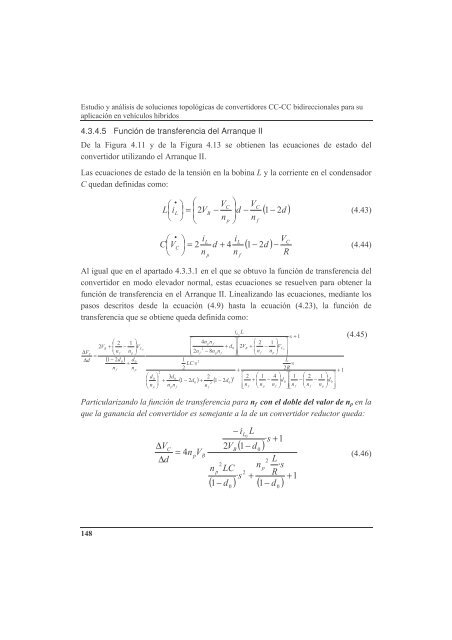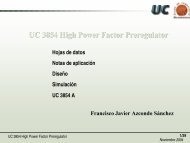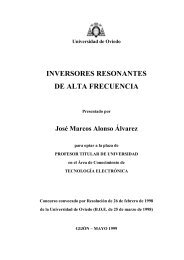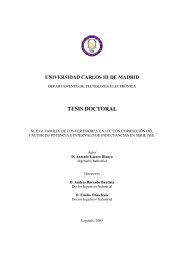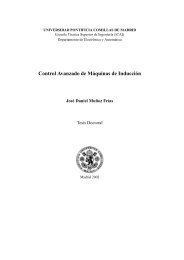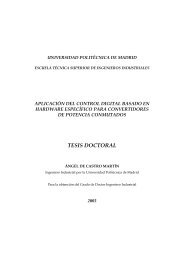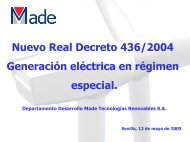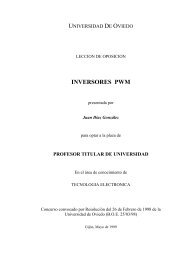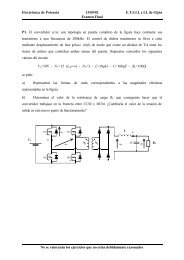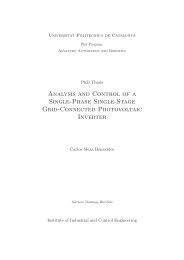- Page 1:
UNIVERSIDAD POLITÉCNICA DE MADRID
- Page 5:
Tribunal Tribunal nombrado por el M
- Page 9:
Agradecimientos Quiero agradecer a
- Page 12 and 13:
Estudio y análisis de soluciones t
- Page 15 and 16:
Índice de Figuras Índice de Figur
- Page 17 and 18:
Índice de Figuras Figura 3.44 Arra
- Page 19:
Índice de Figuras Figura 4.39 (10
- Page 22 and 23:
Estudio y análisis de soluciones t
- Page 24 and 25:
Estudio y análisis de soluciones t
- Page 26 and 27:
Estudio y análisis de soluciones t
- Page 28 and 29:
Estudio y análisis de soluciones t
- Page 30 and 31:
Estudio y análisis de soluciones t
- Page 32 and 33:
Estudio y análisis de soluciones t
- Page 34 and 35:
Estudio y análisis de soluciones t
- Page 36 and 37:
Estudio y análisis de soluciones t
- Page 38 and 39:
Estudio y análisis de soluciones t
- Page 40 and 41:
Estudio y análisis de soluciones t
- Page 42 and 43:
Estudio y análisis de soluciones t
- Page 44 and 45:
Estudio y análisis de soluciones t
- Page 46 and 47:
Estudio y análisis de soluciones t
- Page 48 and 49:
Estudio y análisis de soluciones t
- Page 50 and 51:
Estudio y análisis de soluciones t
- Page 53 and 54:
Convertidor Reductor - Puente Bidir
- Page 55 and 56:
Convertidor Reductor - Puente Bidir
- Page 57 and 58:
Convertidor Reductor - Puente Bidir
- Page 59 and 60:
Convertidor Reductor - Puente Bidir
- Page 61 and 62:
Convertidor Reductor - Puente Bidir
- Page 63 and 64:
Convertidor Reductor - Puente Bidir
- Page 65 and 66:
Convertidor Reductor - Puente Bidir
- Page 67 and 68:
Convertidor Reductor - Puente Bidir
- Page 69 and 70:
Convertidor Reductor - Puente Bidir
- Page 71 and 72:
Convertidor Reductor - Puente Bidir
- Page 73 and 74:
Convertidor Reductor - Puente Bidir
- Page 75 and 76:
Convertidor Reductor - Puente Bidir
- Page 77 and 78:
Convertidor Reductor - Puente Bidir
- Page 79 and 80:
Convertidor Reductor - Puente Bidir
- Page 81 and 82:
Convertidor Reductor - Puente Bidir
- Page 83 and 84:
Convertidor Reductor - Puente Bidir
- Page 85 and 86:
Convertidor Reductor - Puente Bidir
- Page 87 and 88:
Convertidor Reductor - Puente Bidir
- Page 89 and 90:
Convertidor Reductor - Puente Bidir
- Page 91 and 92:
Convertidor Reductor - Puente Bidir
- Page 93 and 94:
Convertidor Reductor - Puente Bidir
- Page 95 and 96:
Convertidor Reductor - Puente Bidir
- Page 97 and 98:
Convertidor Reductor - Puente Bidir
- Page 99 and 100:
Convertidor Reductor - Puente Bidir
- Page 101 and 102:
Convertidor Reductor - Puente Bidir
- Page 103 and 104:
Convertidor Reductor - Puente Bidir
- Page 105 and 106:
Convertidor Reductor - Puente Bidir
- Page 107 and 108:
Convertidor Reductor - Puente Bidir
- Page 109 and 110:
Convertidor Reductor - Puente Bidir
- Page 111 and 112:
Convertidor Reductor - Puente Bidir
- Page 113 and 114:
Convertidor Reductor - Puente Bidir
- Page 115 and 116:
Convertidor Reductor - Puente Bidir
- Page 117 and 118:
Convertidor Reductor - Puente Bidir
- Page 119 and 120:
Convertidor Reductor - Puente Bidir
- Page 121 and 122:
Convertidor Reductor - Puente Bidir
- Page 123 and 124: Convertidor Reductor - Puente Bidir
- Page 125 and 126: Convertidor Reductor - Puente Bidir
- Page 127 and 128: Convertidor Reductor - Puente Bidir
- Page 129 and 130: Convertidor Reductor - Puente Bidir
- Page 131 and 132: Convertidor Reductor - Puente Bidir
- Page 133 and 134: Convertidor Reductor - Puente Bidir
- Page 135 and 136: Convertidor Reductor - Puente Bidir
- Page 137 and 138: Convertidor Reductor - Puente Bidir
- Page 139 and 140: Convertidor Reductor - Puente Bidir
- Page 141 and 142: Convertidor puente completo y recti
- Page 143 and 144: Convertidor puente completo y recti
- Page 145 and 146: Convertidor puente completo y recti
- Page 147 and 148: Convertidor puente completo y recti
- Page 149 and 150: Convertidor puente completo y recti
- Page 151 and 152: Convertidor puente completo y recti
- Page 153 and 154: Convertidor puente completo y recti
- Page 155 and 156: CV · s Convertidor puente completo
- Page 157 and 158: Convertidor puente completo y recti
- Page 159 and 160: Convertidor puente completo y recti
- Page 161 and 162: Convertidor puente completo y recti
- Page 163 and 164: Convertidor puente completo y recti
- Page 165 and 166: Convertidor puente completo y recti
- Page 167 and 168: Convertidor puente completo y recti
- Page 169 and 170: Convertidor puente completo y recti
- Page 171 and 172: : Convertidor puente completo y rec
- Page 173: Convertidor puente completo y recti
- Page 177 and 178: Convertidor puente completo y recti
- Page 179 and 180: Convertidor puente completo y recti
- Page 181 and 182: Convertidor puente completo y recti
- Page 183 and 184: Convertidor puente completo y recti
- Page 185 and 186: Convertidor puente completo y recti
- Page 187 and 188: Convertidor puente completo y recti
- Page 189 and 190: Convertidor puente completo y recti
- Page 191 and 192: Convertidor puente completo y recti
- Page 193 and 194: Convertidor puente completo y recti
- Page 195 and 196: Convertidor puente completo y recti
- Page 197 and 198: Convertidor puente completo y recti
- Page 199 and 200: Convertidor puente completo y recti
- Page 201 and 202: Convertidor puente completo y recti
- Page 203 and 204: Convertidor puente completo y recti
- Page 205 and 206: Convertidor puente completo y recti
- Page 207 and 208: Convertidor puente completo y recti
- Page 209 and 210: Convertidor puente completo y recti
- Page 211 and 212: Convertidor puente completo y recti
- Page 213 and 214: Convertidor puente completo y recti
- Page 215 and 216: Convertidor puente completo y recti
- Page 217 and 218: Convertidor puente completo y recti
- Page 219 and 220: Convertidor puente completo y recti
- Page 221 and 222: Convertidor puente completo y recti
- Page 223 and 224: Convertidor puente completo y recti
- Page 225 and 226:
Convertidor puente completo y recti
- Page 227:
Convertidor puente completo y recti
- Page 230 and 231:
Estudio y análisis de soluciones t
- Page 232 and 233:
Estudio y análisis de soluciones t
- Page 235 and 236:
Referencias 6 Referencias INTRODUCC
- Page 237 and 238:
Referencias [20] Zhang, M.T.; Jovan
- Page 239 and 240:
Referencias [39] Cho, J.G.; Baek, J
- Page 241 and 242:
Anexo I Anexo I Hoja de cálculo Ca
- Page 243 and 244:
Anexo I Tensiones de bloqueo en sem
- Page 245 and 246:
Anexo I n sel ⋅VB tip d := Vc tip
- Page 247 and 248:
Anexo I Corriente en D2 I D2 ( t) :
- Page 249 and 250:
Anexo I Corriente en D7 y D10 ó D8
- Page 251 and 252:
Anexo I Condensador de salida VB Re
- Page 253 and 254:
Anexo I 10 6 d⋅T 2 ( 1+ d) 2 ⋅T
- Page 255 and 256:
Anexo I Pérdidas por convivencia "
- Page 257 and 258:
Anexo I PSMN020-150W R on := 1.8⋅
- Page 259 and 260:
Anexo I Pérdidas D7 - D10 Están r
- Page 261 and 262:
Anexo I Convertidor BI-Direccional
- Page 263 and 264:
Anexo I Permanente ó Normal, modo
- Page 265 and 266:
Anexo I Corriente en la bobina I L1
- Page 267 and 268:
Anexo I Corriente i p del transform
- Page 269 and 270:
Anexo I Condensador de entrada VB R
- Page 271 and 272:
Anexo I 15 9 I Cc ( t) V Cc ( t) 3
- Page 273 and 274:
Anexo I Cálculo de pérdidas ensem
- Page 275 and 276:
Anexo I Pérdidas por "Capacitancia
- Page 277 and 278:
Anexo I Pérdidas por conducción R
- Page 279 and 280:
Anexo I Pérdidas por "Capacitancia
- Page 281 and 282:
Anexo II Anexo II Hoja de cálculo
- Page 283 and 284:
Anexo II MODO ELEVADOR El convertid
- Page 285 and 286:
Anexo II Relación de Transformaci
- Page 287 and 288:
Anexo II Nsel = 7 Arranque I Variac
- Page 289 and 290:
Anexo II Evaluación de la tensión
- Page 291 and 292:
Anexo II Observaciones: _ Es conven
- Page 293 and 294:
Anexo II Recordemos la tensión en
- Page 295 and 296:
Anexo II Corriente que circula en c
- Page 297 and 298:
Anexo II Corriente que el condensad
- Page 299 and 300:
Anexo II PÉRDIDAS EN SEMICONDUCTOR
- Page 301 and 302:
Anexo II Modo Elevador El convertid
- Page 303 and 304:
Anexo II Corriente Total I LT ( t)
- Page 305 and 306:
Anexo II Corriente en condensador d
- Page 307 and 308:
Anexo II PÉRDIDAS EN SEMICONDUCTOR
- Page 309 and 310:
Anexo II HUF75639P3 C oos := 350pF
- Page 311 and 312:
Anexo II Tensión aplicada a las bo
- Page 313 and 314:
Anexo II Cálculo del condendensado
- Page 315 and 316:
Anexo II 1 Rizado de tensión (%)
- Page 317 and 318:
Anexo II ⎝ −⎛ ⎜ ⎝ Vc nF
- Page 319 and 320:
Anexo II ∆i 1 I 1 ( t) := m 1 ⋅
- Page 321 and 322:
Anexo III Anexo III Esquemáticos y
- Page 323 and 324:
Anexo III Cara inferior 297
- Page 325 and 326:
Anexo III Placa de potencia del Con


